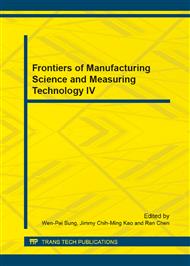[1]
S.T.S. Bukkapatnam, P.K. Rao, W.C. Lih, N. Chandrasekaran, R. Komanduri, Process characterization and statistical analysis of oxide CMP on a silicon wafer with sparse data, Appl. Phys. 88 (2007) 785-792.
DOI: 10.1007/s00339-007-4082-x
Google Scholar
[2]
H. Lei, J.B. Luo, CMP of hard disk substrate using a colloidal SiO2 slurry: preliminary experimental investigation, Wear 257 (2004) 461-470.
DOI: 10.1016/j.wear.2004.01.017
Google Scholar
[3]
H. Lei, H. Li, P. Liu, R.L. Chen, Preparation and polishing properties of spherical porous silica abrasive, Am. J. Nanotechnol. 1 (2010) 32-39.
Google Scholar
[4]
P.V. Velden, Chemical mechanical polishing with fixed abrasives using different subpads to optimize wafer uniformity, Microelectron. Eng. 50 (2000) 41-46.
DOI: 10.1016/s0167-9317(99)00262-2
Google Scholar
[5]
S.J. Li, S. Clara, L.Z. Sun, S. Tsai, F.Q. Liu, A low cost and residue-free abrasive-free copper CMP process with low dishing, erosion and oxide loss, IEEE International Interconnect Technology Conference, 2000, pp.264-266.
DOI: 10.1109/iitc.2001.930039
Google Scholar
[6]
S. Balakumar, T. Haque, A.S. Kumar, Wear phenomena in abrasive-free copper CMP process, J. Electrochem. Soc. 152 (2005) 867-874.
DOI: 10.1149/1.2051954
Google Scholar
[7]
S. Balakumar, T. Haque, R. Kumar, et al., Investigation on abrasive free copper chemical mechanical planarization for Cu/low k and Cu/ultra k interconnects, Mater. Res. Soc. Symp. Proc. 867 (2005) 21-33.
DOI: 10.1557/proc-867-w1.7
Google Scholar
[8]
Y. Hayashi, K. Kikuta, T. Kikkawa, A new abrasive-free, chemical mechanical polishing technique for aluminum metallization of ULSI devices IEDM, 1992, pp.976-978.
DOI: 10.1109/iedm.1992.307520
Google Scholar
[9]
S. Hayashi, T. Koga, M.S. Goorsky, Chemical mechanical polishing of GaN, J. Electrochem. Soc. 155 (2008) 113-116.
DOI: 10.1149/1.2818776
Google Scholar
[10]
S. Yasuhisa, A. Kenta, Y. Kazuto, Abrasive-Free Polishing of SiC Wafer Utilizing Catalyst, 224th ECS Meeting, 2013, pp. (1952).
DOI: 10.1149/ma2013-02/25/1952
Google Scholar
[11]
R. Zhao, H. Lei, Effect of K2S2O8 on material removal rate in abrasive-free polishing of hard disk substrate, Adv. Mater. Res. 690-693 (2013) 3222-3225.
DOI: 10.4028/www.scientific.net/amr.690-693.3222
Google Scholar
[12]
W.T. Zhang, H. Lei, Abrasive-free polishing of hard disk substrate with H2O2-K2S2O8-NaHSO3 slurry, Adv. Mater. Res. 690-693 (2013) 3209-3212.
DOI: 10.1007/s40544-013-0032-0
Google Scholar
[13]
Z.J. Wang, H. Lei, Cu (Ⅱ) as a catalyst for hydrogen peroxide system abrasive-free polishing on hard disk substrate, Key Eng. Mater. 562-565 (2013) 91-95.
DOI: 10.4028/www.scientific.net/kem.562-565.91
Google Scholar
[14]
S.S. Chen, H. Lei, et al., Effect of pH on hard disk substrate polishing in glycine-hydrogen peroxide system abrasive-free slurry, Key Eng. Mater. 562-565 (2013) 691-696.
DOI: 10.4028/www.scientific.net/kem.562-565.691
Google Scholar


